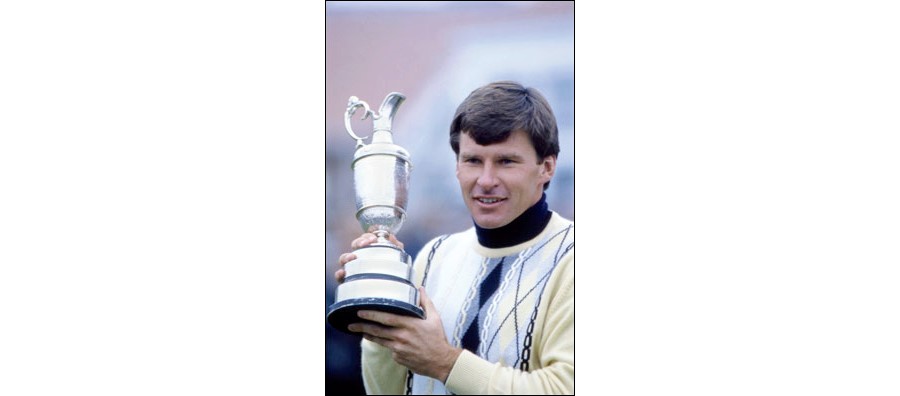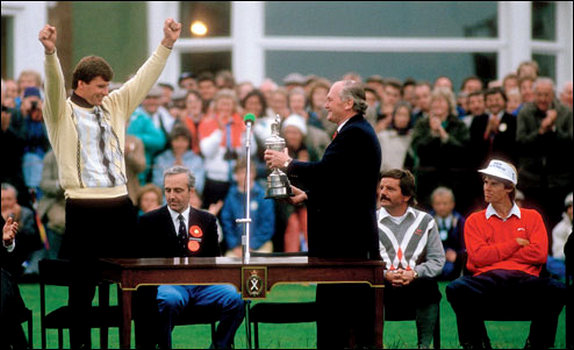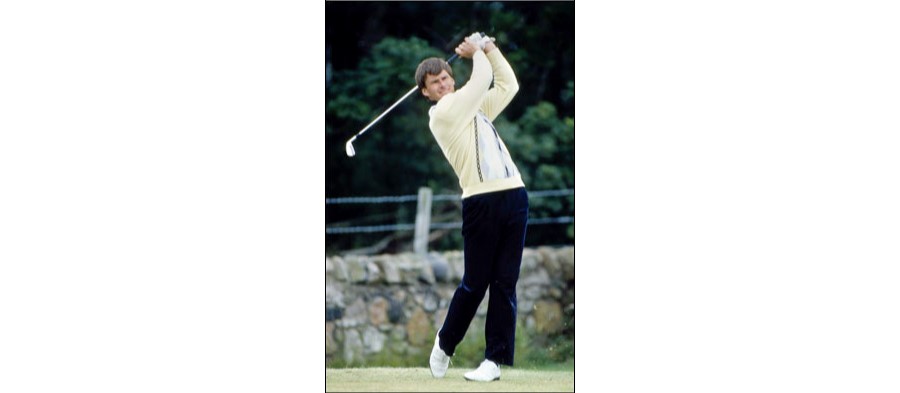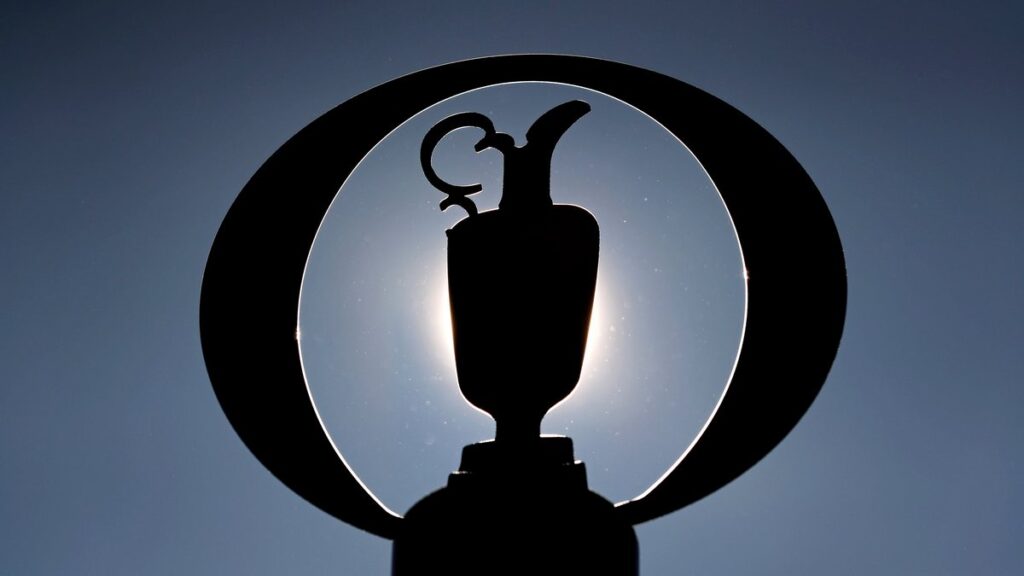Open 1987 – Nick Faldo
Has there been a more iconic round of golf played in the course of winning a major championship? Certainly, in the context of his own career, the 18 pars Nick Faldo forged around a dank, unrelenting Muirfield on Sunday July 19 1987 couldn’t have been more prosaic; after a lengthy period in limbo, a three-year hiatus deconstructing his swing under the eye of his coach, David Leadbetter, the ball-striking control and mental resiliance the former European No.1 displayed would signal the dawn of a new world order.
Richard Simmons

Estimated reading time: 15 minutes
The story of course is history now. The tale of a single-minded boy from Welwyn Garden City – “a sportsman looking for a sport” – who decided, upon watching TV images of Jack Nicklaus at Augusta, that he would be the game’s next great champion.
Open 1987 – Nick Faldo
Credit where it’s due. After notching up a number of major amateur victories, the British Youths and the Lytham Trophy among them, Faldo turned pro in 1976. His star was not so much rising as shooting to the stellar heights he had no doubt he could reach.
In 1977, then just 19 years old, he defeated Tom Watson – the reigning Open Champion – in the Ryder Cup singles at Lytham and within just a handful of years would establish himself as the European No 1. Stepping stones – no more than that. And yet when he found himself in the thick of it in the Birkdale Open of 1983, Faldo hit a brick wall; for all the promise and giddy speculation he simply did not have the necessary control of the ball to make that final step to greatness. The swing, so Faldo decided, just wasn’t good enough.

Open 1987 – Nick Faldo
The back story to one of the game’s most remarkable comebacks will long stand in the memory of those who followed the collaboration between Faldo and one David Leadbetter, in 1984 a little- known coach with grand designs all his own.
The painstaking exercise of breaking down and rebuilding a swing piece by piece reflects the character of the two individuals central to the story – precise, obsessed with detail, crazy in their love for the game of golf and determined to succeed. And both of them so talented they would have made it alone, one way or the other. But the double act worked, the timing couldn’t have been any better, and when Faldo emerged in 1986 he did so with a bullet-proof swing that was characterised by a body action that simply wouldn’t quit, a framework that allowed the intuitive feel in his hands and arms to reign supreme.
Open 1987 – Nick Faldo
The granite links of Muirfield provided the perfect canvas – perhaps the ultimate test of a golfer’s ability to churn out one controlled shot after another; a championship course that examines a golfers armoury more fully perhaps than any links on the Open rota. Faldo arrived in 1987 with his confidence high after a good ball striking week at the Scottish Open (and this after victory a couple of months previously in the Spanish Open). The belief had never really deserted him; only now he had the swing to validate his conviction.
Muirfield 1987 was significant not only for the fact that Faldo added his name to an elite list of former winners in this storied enclave of East Lothian, but for the fact it signalled the start of a decade in which he would be regarded as the finest player in the world – and the most prolific winner of major championships before Tiger came along.
It is nothing but a poignant coincidence that Faldo – approaching 40 and the defending Masters champion – played the opening round alongside Woods, 21, in 1997; the man who dominated the game of golf in a golden era witnessing at first hand the arrival of the man who would, single-handedly, take it to a new one entirely.
***
When you look back at that round in 1987, where does it rate in your alltime list?
To win your first major championship? It has to be No. 1. It sounds boring doesn’t it, 18 pars at Muirfield. But that was very, very special. That and my last-day 67 at Augusta in 1996, I’d say those are the best and most significant rounds in my career. The book-ends to my six major titles.
The emotion of winning your first major must have been extraordinary?
Just look at the reaction we saw in Adam Scott at Augusta this year (1993). It’s hard to explain the intensity of it all when you’re trying to get over that line for the first time in your career. It is like nothing you’ve ever witnessed before. It’s 10 times greater than anything else you will ever experience on a regular Sunday. The volume is cranked up to 11 on absolutely everything. I remember having this conversation with Michael Campbell after he won the US Open (in 2005), and Trevor Immelman after he won the Masters (in 2008); they simply couldn’t believe the intensity of it all. As much as you try to stay calm and keep a lid on it, the situation you find yourself in – the situation you have dreamed about for so long – cranks up the emotions, your thinking, your reaction times, everything. You have all this going on and if you sense something special is happening, which I did at Muirfield, you experience the belief you can do it. After the build up, the swing change, turning 30 that weekend, for me it was just a great time to win an Open. That was sheer elation and emotion at winning my first major; the Masters in ’96 was a mental battle to hit shot after shot under the pressure and with the atmosphere unique to Augusta and of course with all that was happening to Greg.
What do you remember most about the first three rounds in ‘87?
We certainly had the worst of the draw, weather-wise. I played with Nick Price and Ray Floyd and I can remember Ray came up to me after the first 36 and he said: “You can feel good about that golf – we had the worst of it out there.” It was just pea soup, with a decent breeze. I was all wrapped up, I remember, dark corduroy trousers, blue cashmere roll neck and favourite cashmere sweaters. I think I wore the same cords the last two days – not because I’m superstitious, they were the warmest trousers I had with me!
What were the keys you took to Muirfield – the swing cues that worked for you that week?
I really wish I’d written it all down now!
We were big on the whole rotation idea, which was the major part of the antidote to my previous tendency, which was to drag the grip of the club away from the ball with too much lag. I had learned to rotate my arms with my body, and the waggle was a key thing for me to maintain all the good sensations that I knew set me off on the right track. If you look back at the TV footage, the pre-shot routine and the waggle was significant – it was a big ‘one-two’ waggle, and then I went. I learned a new wrist action, how to rotate the arms and keep the club working in sync with the body, and then re-rotate through impact. I used to think in terms of collecting the golf ball. Now the guys just explode into it.
Wooden drivers, squishy balata balls – it was ‘only’ 26 years ago – was the game really all that different?
Yeah, it really was in that era. That was different to the way the guys are hitting it today. I remember talking to Lee Trevino back in the day, and he was telling me how much he enjoyed the feeling of seeing how long he could keep the ball on the clubface. How long could he compress it. That’s what we used to do. We would squash the thing. Now it’s how quickly you can get the ball off the face. The game is explosive, it’s all about power. Look at the old swings – it was a brush stroke, collecting the ball, more about the finesse and working it.
You won the Spanish Open in May that season – was there a growing sense of inevitability, that you knew you were getting close to realising your dream?
It was funny. After that win in Spain I remember telling myself that I needed to win one more tournament before the Open – my whole life was about winning the Open. Then I thought to myself, ‘No, I’m alright, I’m ready.’ Things were slotting into place. One evening early in the week at Muirfield I was out on the practice green messing about with a putter, and as I walked back to the clubhouse I glanced up at the giant yellow scoreboard and saw my name sitting at the top of the leaderboard. I thought: ‘That’s OK. I can handle that.’ I could see myself sitting in the studio on Monday morning doing breakfast TV with the claret jug… There’s your visualisation. Some people will agree – others think it’s baloney. But if you have a positive thought I’m a great believer you gravitate towards it.

Open 1987 – Nick Faldo
You talk about experiencing a focus like never before – the clarity of your thinking, strategy and concentration out on the course.
I was in the zone the whole week – or a ‘cocoon’ as Tony Jacklin liked to call it. On that Sunday, I was engrossed in my own little world, emotionally, just doing my own thing and getting so deep in my own concentration that I was more or less oblivious to what was going on around me. As I was walking I focused on just a couple of steps in front of me. I’d get to the ball, and playing the next shot was all that matters. Hit it, walk after it and go through the same routine again. I was nervous but I could still play. I didn’t putt very well, which I think was just a problem releasing the putter. But I had a number of great scrambles, particularly on 7, 8 and 10.
Did it ever cross your mind that you would shoot 18 straight pars?
No! I was thinking ‘When am I going to make a birdie!’ I remember lining up all of these putts and just leaving the ball short of the hole – that was the nerves, I didn’t release the putter the way I normally did. But I holed all of the short ones, and that’s what matters.
I read that your ambition was to be a millionaire by the time you were 30 – you turned 30 on the Saturday, I guess you were a day out!
We used to talk about there being a ‘window’ from 25-35 being the prime of your golfing life. That may have been extended today, players are fitter and of course all the technology helps. But it was the way we used to think about it then. So yes, this was a good time in my career to make my move. After the swing change, I’m a new dad, daughter Natalie was there, just learning to walk, and it’s another chapter in your life.
The thing is, in those days, you had to win to make a real difference to your life. If you were a journeyman in those days you didn’t drive a fancy car, you travelled on a budget and it was a pretty ordinary life. You watched your pennies. These days, you can be a journeyman, yet to win a tournament, and you earn two million dollars in a season. Throw in a few corporate outings, bish-bash-bosh and they are earning three million bucks. That’s a pretty damn good job. Look around at the talented youngsters out there today, they can have everything – the house, the cars, all the toys – without winning. This is why I think you have to be careful – winning is the difference. You have to dig deep, to want to win trophies, to be a winner. We had to win to make a difference and to turn left on an aeroplane – now all these young guys fly private.
Open 1987 – Nick Faldo
Without wishing to get side-tracked, is money too easy to come by for a lot of these players?
Well, in my opinion money certainly shouldn’t be the key element in any decision making that affects your golf. Look at Rory [McIlroy]. People go “Wow, what a great contract – look at all those zeros.” But the kid was already grossing probably $30 million dollars a year, he has the 15,000 square foot house in Florida, the cars, the boats, whatever he wants. He gets dangled a massive contract which will not change his lifestyle. Now he has serious obligations. Before he just grabbed his clubs and went out to play. The biggest gainer out of it all was the manager – that was certainly a deal that changed his lifestyle. Bottom line: money shouldn’t have been the priority. He was a two-time major champion, the hottest player on the planet under 25, world No.1 – when the phone rings you just pick it up and give them the number. When the manager has to call out, then you see how good they are. All Rory needed to worry about was his golf game – how well can he play for the next 15 years? That’s it. Be a golfer.

Open 1987 – Nick Faldo
Two of your three Opens were won at Muirfield – you share that honour with James Braid. Sir Henry Cotton, Jack Nicklaus and Tom Watson are among the other Muirfield champions – what is it about the course that identifies the best ball strikers?
I think it’s pretty complete. It’s a good, solid, honest golf course. It’s pretty long, the weather conditions play a part, obviously. It’s about placement, and the only way you can get the ball to do what you want it to do is strike it properly. The rough is deep, so you need to be a good driver of the ball, there are a lot of runup areas into the greens, so you also need to be able to control and ‘feed’ the ball with your iron shots. Around the greens you are tested with some seriously good bunkers and run-off areas that test your short game; on them you need to be a good reader of lines because the greens are fairly natural. I didn’t fully appreciate this before going back in 2002, unlike modern greens with built-in ridges and drop offs, these are as the ground was when the course was built 150 years ago, it’s the original lie of the land.
You get ripples and little twisty putts, they are difficult, irregular greens. Strategy is obviously important: do you lay up short of bunkers, do you fly them? I think the ability to work the ball both ways is a big help. I know I enjoyed banking the ball against the wind, such as my 5-iron ‘chicken-wing’ fade into the 15th in 1992. But the biggest compliment I can pay is to say that Muirfield is a big, honest and fair golf course.
What was going through your mind over that final putt. It’s one of those situations we all dream about as kids – this for the Open.
Well, I was pretty nervous, I do remember that! On the second shot it was like everything happened in super-slow motion. Standing in the fairway I was dying to hit a half 4-iron, but I just couldn’t bring myself to hit that shot, so I went with the 5. I hit a pretty good shot, but it pitched into the upslope at the very front of the green and stopped. I blocked the first putt, raced it, and now I have a five-footer. I looked up at the leaderboard and saw Rodger Davis was in at four under. I thought ‘well, you can’t miss this otherwise you’re not going to win.’ The nicest thing was, as I got over it and took the thing back, a little voice in my head just went ‘Yeah!’.
Which is precisely what Rule 14-1b is designed to protect – the integrity of the game, the fact that to win a major all comes down to having the bottle to make a putt like that with a regular putter?
That’s what I believe. That’s what we’re all out here for – it’s the way the game was intended. It’s not a hinge – it’s called a golf swing.
You’re taking time off the day job to play this year – how are the preparations going?
I’m trying to gear up – it’s an interesting exercise! While I like to hit balls I don’t play competitive golf, so that’s the tough part. I’ve had a few injuries in my shoulder, but I’ve been training hard. I’m having to live by the same rules I preach to the youngsters on the Faldo Series, about the value of golf-specific training and so on. I have six weeks or so to get the muscles strong enough to play. It’s like having a 60,000 mile service!
I think this will more than likely be my last hoorah at the Open, so I’m simply going to enjoy it – que sera sera. I will be out of age next time the Open returns to Muirfield, I’m trying to gear up – it’s an interesting pretty fit – or at least I think I’m fit – so I thought why not just go there and enjoy it, do the Open walk. The practice rounds should certainly be a lot of fun and I’m looking forward to engaging with the fans. I don’t really care what I shoot; I will go out there and do my level best on each and every shot. If it adds up to 82, I can accept that. Muirfield has a special place in my heart and playing there in front of the fans one last time, that’s going to be the best part of it all. I want to enjoy it and connect.
Perhaps draw some inspiration from Peter Dazeley’s black and white photos of you warming up on the range that Sunday?
It really was the dawn of a new era. And looking at the black and white images that Peter Dazeley took really does bring it all home to me. This is it: the Sunday morning on the practice ground before it all happened. The pea soup, and there’s the club on the ground for alignment that I’m always harping on about. It was a great atmosphere, full of anticipation and there were certainly butterflies. It’s the same sort of emotion you experience with a first baby arriving – and your life changes forever!
Open 1987 – Nick Faldo
Originally posted in 2014
